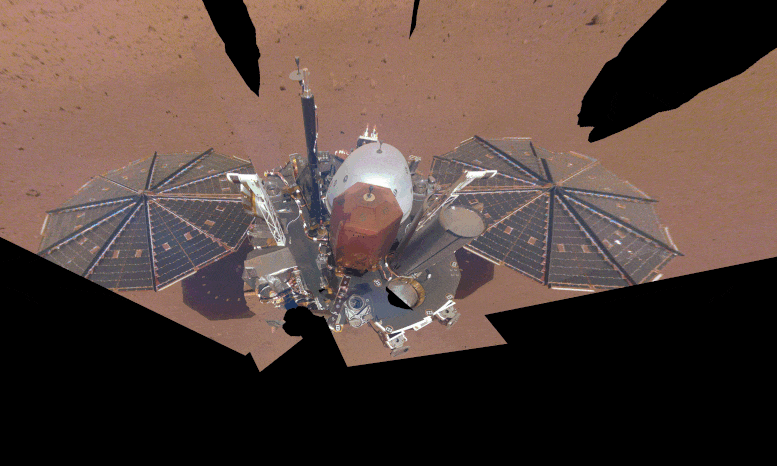
Esta imagen se alterna entre la primera y la última selfie de Insight, con fines comparativos. Usando la cámara en su brazo robótico, la sonda InSight de la NASA capturó estos selfies el 6 de diciembre de 2018, solo 10 días después de aterrizar en Marte, y el 24 de abril de 2022. Se puede ver una gruesa capa de polvo en la sonda y sus paneles solares en la ultima imagen Crédito: NASA/JPL-Caltech
Eche un vistazo más de cerca a lo que implica completar una misión a medida que la fuente de alimentación de la nave espacial InSight continúa disminuyendo.
final cercano a[{» attribute=»»>NASA’s Mars InSight lander. The day is fast approaching when the spacecraft will fall silent, ending its history-making mission to reveal secrets of the Red Planet’s interior. Since the spacecraft’s power generation continues to decline as windblown dust on its solar panels thickens, the engineering team has already taken steps to continue as long as possible with what power remains. Despite these efforts, it won’t be long now, as the end is expected to come in the next few weeks.
Although InSight’s tightknit 25-to-30-member operations team – a small group compared to other Mars missions – continues to squeeze the most they can out of InSight, they’ve also begun taking steps to wind down the mission.
Here’s a glimpse of what that looks like.

This is NASA InSight’s first full selfie on Mars. It displays the lander’s solar panels and deck. On top of the deck are its science instruments, weather sensor booms, and UHF antenna. The selfie was taken on December 6, 2018 (Sol 10). Credit: NASA/JPL-Caltech
Preserving Data
With InSight (short for Interior Exploration using Seismic Investigations, Geodesy and Heat Transport), the most important of the final steps of the mission is storing its trove of data and making it accessible to researchers around the world. Already, the data from the lander has yielded details about Mars’ interior layers, its liquid core, the surprisingly variable remnants beneath the surface of its mostly extinct magnetic field, weather on this part of Mars, and lots of quake activity. More insights are sure to follow, as scientists continue to sift through the data.
InSight’s seismometer, provided by France’s Centre National d’Études Spatiales (CNES), has detected more than 1,300 marsquakes since the lander touched down in November 2018. The largest quake it detected measured a magnitude 5. It even recorded quakes from meteoroid impacts. Observing how the seismic waves from those quakes change as they travel through the planet offers an invaluable glimpse into Mars’ interior. Beyond that, these observations also provide a better understanding of how all rocky worlds form, including Earth and its Moon.

NASA’s InSight Mars lander took this final selfie on April 24, 2022, the 1,211th Martian day, or sol, of the mission. The lander is covered with far more dust than it was in its first selfie, taken in December 2018, not long after landing. Credit: NASA/JPL-Caltech
“Finally, we can see Mars as a planet with layers, with different thicknesses, compositions,” said Bruce Banerdt of NASA’s Jet Propulsion Laboratory (JPL) in Southern California, the mission’s principal investigator. “We’re starting to really tease out the details. Now it’s not just this enigma; it’s actually a living, breathing planet.”
The seismometer readings will join the only other set of extraterrestrial seismic data, from the Apollo lunar missions, in NASA’s Planetary Data System. They will also go into an international archive run by the Incorporated Research Institutions for Seismology, which houses “all the terrestrial seismic network data locations,” said JPL’s Sue Smrekar, InSight’s deputy principal investigator. “Now, we also have one on Mars.”
Smrekar said the data is expected to continue yielding discoveries for decades.

The rocket that launched NASA’s InSight lander to Mars in 2018 is seen at Vandenberg Air Force Base, now called Vandenberg Space Force Base. Credit: NASA/JPL-Caltech/Charles Babir
Managing Power
Earlier this summer, the lander had so little power remaining that the mission turned off all of InSight’s other science instruments in order to keep the seismometer running. They even turned off the fault protection system that would otherwise automatically shut down the seismometer if the system detects that the lander’s power generation is dangerously low.
“We were down to less than 20% of the original generating capacity,” said Banerdt. “That means we can’t afford to run the instruments around the clock.”
Recently, after a regional dust storm added to the lander’s dust-covered solar panels, the team decided to turn off the seismometer altogether in order to save power. Now that the storm is over, the seismometer is collecting data again. However, the mission expects the lander only has enough power for a few more weeks.
Of the seismometer’s array of sensors, only the most sensitive were still operating, said Liz Barrett, who leads science and instrument operations for the team at JPL, adding, “We’re pushing it to the very end.”
paquetes gemelos
El miembro silencioso del equipo es ForeSight, el modelo de ingeniería de tamaño completo de InSight en JPL Laboratorio de herramientas en el lugar. Los ingenieros usaron ForeSight para practicar cómo InSight podría colocar instrumentos científicos en la superficie de Marte usando el brazo robótico del rover. Técnicas de prueba Para colocar la sonda de temperatura de la sonda El suelo pegajoso de Martedesarrollando métodos Reducción de ruido Recogido por un sismómetro.
Forsight se colocará en una caja de almacenamiento. “Lo llenaremos con amoroso cuidado”, dijo Banerdt. «Ella fue una gran herramienta, una gran compañera para nosotros en toda esta misión».

En un espacio de prueba en el Laboratorio de Propulsión a Chorro, los ingenieros se están entrenando para implementar instrumentos InSight utilizando ForeSight, una réplica de tamaño completo del módulo de aterrizaje que se movilizará una vez que se complete la misión. Muchos ingenieros usan gafas de sol para bloquear las luces amarillas brillantes que imitan la luz del sol cuando aparecen en Marte. Crédito: NASA/JPL-Caltech/IPGP
Anuncio de fin de misión
Cuando InSight pierde dos sesiones de contacto consecutivas con la nave espacial que orbita Marte, parte de Red de retransmisión de MarteLa NASA anunciará el final de la misión. Sin embargo, esta regla solo se aplica si la causa de la pérdida de conexión es la propia sonda, dijo el administrador de red Roy Gladden de JPL. Después, Red de espacio profundo de la NASA Seguirá escuchando durante un rato, por si acaso.
Sin embargo, no habrá acciones heroicas para volver a conectar con InSight. Aunque un evento que salve la misión, como un viento fuerte que limpie los paneles, no es imposible, se considera completamente improbable.
Mientras tanto, mientras InSight permanezca en contacto, el equipo continuará recopilando datos. «Continuaremos haciendo mediciones científicas durante el mayor tiempo posible», dijo Banerdt. «Estamos a merced de Marte. El clima en Marte no es lluvia y nieve; el clima en Marte es polvo y viento».
Más sobre la misión
El Laboratorio de Propulsión a Chorro (JPL) de la NASA administra el programa InSight de la Dirección de Misiones Científicas de la NASA. InSight es parte del Programa Discovery de la NASA, que es administrado por el Centro de Vuelo Espacial Marshall de la agencia en Huntsville, Alabama. Lockheed Martin Space de Denver ha construido la nave espacial InSight, que incluye una etapa de crucero y un módulo de aterrizaje, y respalda las operaciones de la nave espacial de la misión.
Varios socios europeos, incluido el Centro Nacional Francés de Estudios Espaciales (CNES) y el Centro Aeroespacial Alemán (DLR), están apoyando la misión InSight. El Centro Nacional de Estudios Espaciales ha proporcionado el instrumento Experimento sísmico de estructura interna (SEIS) a la NASA, con el investigador principal del IPGP (Institut de Physiques d’Institut d’Institut d’Institut d’Institut d’Institut du Physique en el Mundo en París). Las contribuciones significativas al Sistema Común de Información Ambiental provinieron del IPGP; Instituto Max Planck para la Investigación del Sistema Solar (MPS) en Alemania; Instituto Federal Suizo de Tecnología (ETH Zurich) en Suiza;[{» attribute=»»>Imperial College London and Oxford University in the United Kingdom; and JPL. DLR provided the Heat Flow and Physical Properties Package (HP3) instrument, with significant contributions from the Space Research Center (CBK) of the Polish Academy of Sciences and Astronika in Poland. Spain’s Centro de Astrobiología (CAB) supplied the temperature and wind sensors, and the Italian Space Agency (ASI) supplied a passive laser retroreflector.

«Experto en la web. Fanático de la cerveza exasperantemente humilde. Fanático del tocino. Creador típico. Experto en música».





More Stories
¿Cómo se hicieron los agujeros negros tan grandes y rápidos? La respuesta está en la oscuridad.
Una vaca marina prehistórica fue devorada por un cocodrilo y un tiburón, según los fósiles
El lanzamiento del cohete Falcon 9 de SpaceX se ha detenido a medida que se acercan dos importantes misiones de vuelos espaciales tripulados.